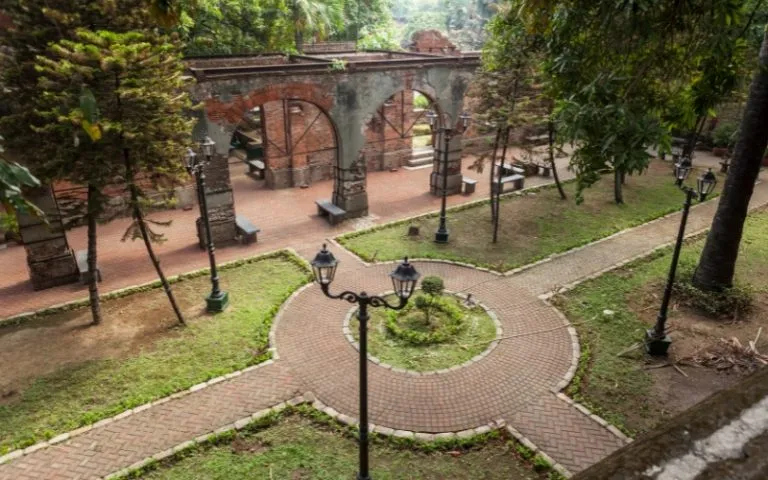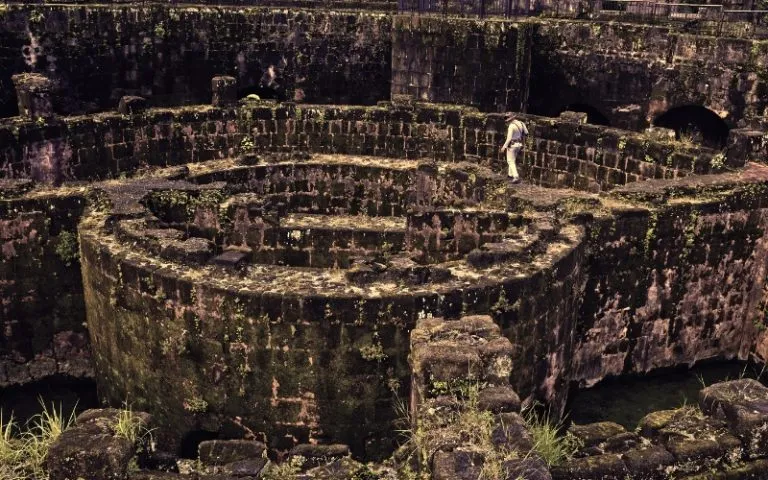Our favourite places to stay on this sleepy Cebu island.
10 Intramuros Tourist Spots: An Essential Guide for Pinoys

Most Pinoys would have an idea of what the essential Intramuros tourist spots are; colonial buildings make up the bulk of attractions inside the Walled City. But apart from its structures, Intramuros still functions as a district with more than a few administrative responsibilities, as well as a major district for education. Learn more about these essentials through this list.
Also read: Intramuros at Night: 10 Things to Do in the Walled City
The most essential Intramuros tourist spots to visit
1. Manila Cathedral

Possibly the largest structure inside the Walled City, The Manila Cathedral is simply an institution for Roman Catholics residing in Metro Manila. That fact alone makes it one of the most significant Intramuros tourist spots that Pinoys should definitely know. Built in 1954 by the Spaniards, the cathedral was one of the biggest places of worship among Roman Catholics, and it still is, especially every Sunday.
2. San Agustin Church

Just behind The Manila Cathedral is possibly the most resilient out of all the Intramuros tourist spots there is. San Agustin Church is the oldest church in the Philippines, yet it remains one of the busiest. The strength of this church is infallible, considering that it withstood the devastation brought by World War II.
As one would expect, the history behind this church is fascinating. Luckily, just beside the church is the San Agustin Museum. Relics that show the story behind San Agustin’s formation, struggles, and triumphs can be observed inside.
Also read: 10 Stunning Churches in the Philippines Every Pinoy Must Visit
3. Fort Santiago

During the various occupations that the Philippines went through, Intramuros was considered an invaluable strategic position. Fort Santiago’s proximity to the Pasig River helped develop Intramuros as a prolific stronghold and garrison. Apart from being a massive armoury, the fort was also a storehouse for various spices and precious metals acquired from trading.
But more than a fortification, Fort Santiago is one of the most essential Intramuros tourist spots because of its history as detention and execution grounds for the enemies of ruling colonisers. Philippine National Hero Jose Rizal spent his final hours awaiting execution in one of the fort’s cells. Today, the cell is now a shrine dedicated to Rizal.
Also read: 13 Historical Sites in the Philippines Every History Buff Must Visit
4. Baluarte de San Diego

The ruins of Baluarte de San Diego were once a mighty fort used as a sentry against potential threats from the south. The structure had a striking shape that slightly resembled the ace of spades; look closely, and you’ll still see this form today. Being a fort, Baluarte de San Diego was the site of countless artillery strikes from invaders, which ultimately contributed to its fall.
Ironically, the rubble from Baluarte de San Diego’s destruction prevented further damage to its foundations, making restorations of the historic structure much easier. Today, a lush garden grows at its base, while part of the former barracks can now be rented for private functions.
5. Palacio del Gobernador

Palacio del Gobernador is a historical site from the Spanish Occupation. Before it became the administrative building we know today, the original structure was the Spanish gobernardor’s residence. The residence also served as their office to make sure that enacting policies were efficient. Sadly, the original building collapsed after an earthquake in 1863.
The current iteration of the building was built in the 1970s. Its architecture certainly fits in the heritage village that Intramuros is famous for. Today, it holds offices of the Intramuros Administration and the Commission of Elections (COMELEC).
Also read: Here’s How You Can Hold Events and Activities in Intramuros for Free
6. Casa Manila

Illustrado affluence will always look grand. Visiting Casa Manila provides a glimpse of an opulent Spaniard’s residence in Intramuros. Among Intramuros tourist spots, the casa is the place most likely to be seen in almost any Instagram feed. We can’t blame them, as Casa Manila has endless photo opportunities from every angle.
Among them is the lavish living room: fully furnished with strong wooden tables and chairs from Europe and ornate ceramics from China. Arguably, it’s the casa’s patio that remains consistently picturesque. Whether the sun is bright or illuminated by amber lights at night, Casa Manila is a timeless beauty.
Casa Manila is also the home of the heritage restaurant Barbara’s. You can book a reservation and experience some of the best Filipino cuisines in Manila.
Also read: 10 Classic Restaurants in Intramuros for Timeless Filipino Cuisine
7. National Commission of Culture and Arts

The National Commission of Culture and Arts is a relatively small building, but the wealth it holds is vast, especially for art enthusiasts. Its offices cultivate and preserve Filipino history, culture, and arts for all generations. The lobby doubles as an exhibit for artists, so check their schedules out regularly!
8. Binondo-Intramuros Bridge

One of the newer Intramuros tourist spots, the Binondo-Intramuros Bridge serves as an important addition to creating breathing space for traffic around Metro Manila. Connecting two timeless Manila districts through the wonders of modern architecture seems serendipitous, but it is definitely welcome. Pass by the bridge just before sundown to see its gorgeous lights illuminate the river.
Also read: 10 Things to Do in Binondo, Manila — the Oldest Chinatown in the World
9. Jones Bridge

One of the first bridges in Manila is Jones Bridge. It’s also one of the strongest, as the volume of vehicles that cross this bridge every day is almost countless. It was built during the American Occupation in the 1920s, but ever since it went through a restoration last 2019, it stopped ageing. It also started drawing crowds for its elegant amber lights coming from its restored colonial street lamps. Thanks to the restoration, newer generations can finally see how beautiful its neo-classical architecture is.
Also read: ‘Before Sunrise’-Inspired Photoshoot Transforms Binondo Into Vienna
10. National Museum Complex

Intramuros is a historical city, after all, so why not learn more about the Philippines’ general history? Good thing that the National Museum Complex is just a stone’s throw away from the Walled City. This collective space of knowledge houses four buildings: the National Museum of Anthropology, the National Museum of Fine Arts, and the National Museum of Natural History. It is a treasure trove of information and will definitely enrich a visit to Intramuros even more.
Also read: 15 Must-Visit Museums in the Philippines to Celebrate Pinoy Heritage and History
A city as historic as Intramuros is always a great choice for tours. Its cultural relevance seems to grow more valuable as the years go by. Amusingly, Intramuros’ timeless beauty makes it a treat to soak everything to learn about this important city.
Featured image credit: markandpor via Canva Pro
Published at
About Author
Aldous Vince Cabildo
Subscribe our Newsletter
Get our weekly tips and travel news!
Recommended Articles
10 Bantayan Island Resorts, Hotels, and Rentals for Your Tropical Escape 14 Best Credit Cards for Travel in the Philippines The only plastic we need for travel.
10 Best Mountain Cafes in the Philippines for Your Peak Coffee Experience Coffee date on the mountains, anyone?
My 10-Day Southern Vietnam Backpacking Trip for Less Than ₱15k 10 days in Southern Vietnam with less than ₱15k budget. Learn how this Filipina did it!
10 Fairytale Castles In Europe Filipinos Need To See! Permission to feel like royalty even for a day?!
Latest Articles
Heads Up, Road Trippers! NLEX Toll Fee Hike Now in Effect Here’s what you need to know before your next trip!
China’s Chengdu Snow Village Shuts Down After Fake Snow Backlash A Chinese winter attraction shuts down after tourists expose its fake snow.
First-Time in Singapore? Budget Tips Every Pinoy Must Know! Essential hacks for Pinoys travelling to Singapore on a budget.
Taylor Swift-Inspired Travel: 5 Must-Visit Iconic Locations Visit the real-life locations behind Taylor Swift’s most iconic songs.
Discover MOA Sky: The Hottest New Rooftop Attraction in the Philippines Unwind and play above the city!

